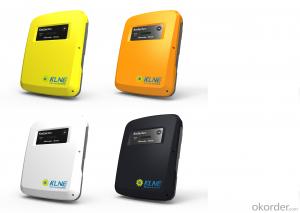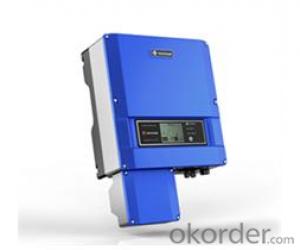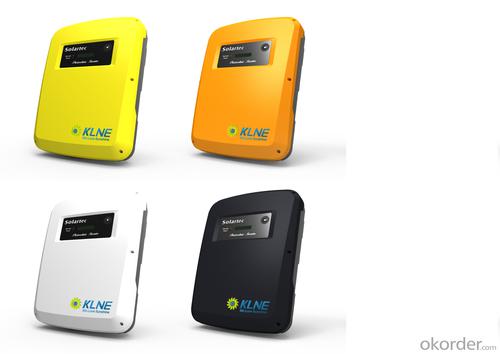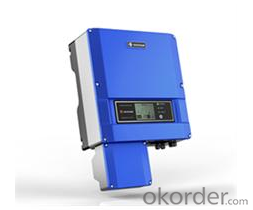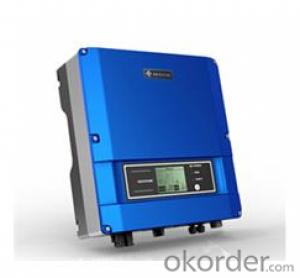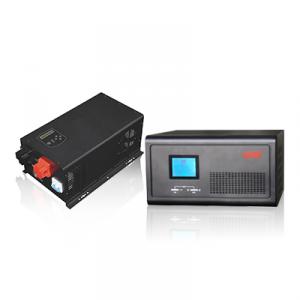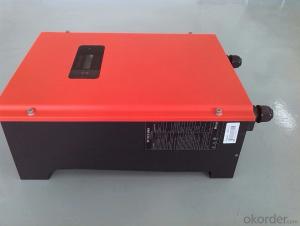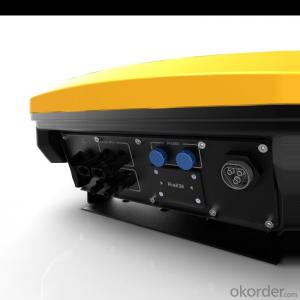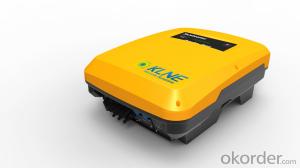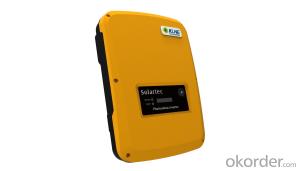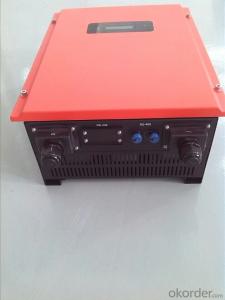50 Kw Solar Inverter Off-Grid Type Solo-200 Series
- Loading Port:
- Shanghai
- Payment Terms:
- TT OR LC
- Min Order Qty:
- 10 unit
- Supply Capability:
- 1000 unit/month
OKorder Service Pledge
OKorder Financial Service
You Might Also Like
Product Description:
This system can keep 5 energy-saving bulbs with 20W working for 5 hours per day and two 5W radios working for 8 hours a day.
Output voltage:5V d. c. (USB port) / 12V d. c.
It can work for 3 successive rainy days.
● System voltage:12V
Ø
● Charge and discharge current:20A
Ø
● Power:200W
Ø
● Dimensions of box:650*250*445mm
Ø
● Net weight of the box:13kg
Ø
● Output DC current:7 phases Product Datasheet:
Main accessories | Specifications | No. | Notes |
Box | High-quality rolled steel | 1 | Standard box, optional colors |
PV modules | Polysilicon 100Wp | 2 pieces | Optional |
Storage battery | Lead acid, maintenance-free, 220Ah | 1 piece | Optional |
Controller | Solo-LS1524S 15A | 1 unit | Standard |
PV accessories shelf | Simple type | 1 set | Optional |
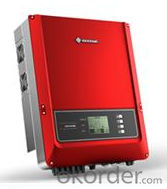
Product Advantages:
Powered by DC current
Can used out of doors
High effiency and low noise
FAQ
What is your payment terms?
We accept T/T payment, normally we need 20% T/T in advance, 80% payed before shipment.
What is your packing system?
We put the sistem in the wooden box.
Can you do OEM service?
Yes we can, but we need to do it with a certain order quantity.
- Q: Can a solar inverter be used with different AC voltage systems?
- Yes, a solar inverter can be used with different AC voltage systems as long as it is compatible with the specific voltage range and frequency of the AC system.
- Q: How does a solar inverter handle voltage and frequency variations caused by switching operations?
- Through its built-in control mechanisms and advanced technology, a solar inverter is specifically designed to handle voltage and frequency variations resulting from switching operations. When connected to the grid, the solar inverter actively monitors the grid's voltage and frequency, and adjusts its operation accordingly to ensure stability and safety. When voltage variations occur due to switching operations, a solar inverter typically employs a voltage control mechanism. This mechanism continuously monitors the grid's voltage level, and accordingly adjusts the inverter's output voltage to match the grid voltage. If the grid voltage exceeds or falls below a specific threshold, the inverter automatically compensates by adjusting its output voltage to maintain a stable level. Similarly, for frequency variations caused by switching operations, a solar inverter utilizes a frequency control mechanism. This mechanism constantly monitors the grid's frequency and adjusts the inverter's output frequency to match the grid's frequency. If the grid's frequency deviates from the standard, the inverter promptly responds by adjusting its output frequency to ensure synchronization with the grid. To achieve precise control, solar inverters often integrate advanced digital signal processing algorithms and sophisticated control systems. These algorithms and control systems analyze the voltage and frequency signals from the grid, and based on predefined parameters, swiftly make adjustments to the inverter's output. This ensures compatibility with the grid and promotes seamless integration. Ultimately, the primary objective of a solar inverter is to seamlessly integrate with the grid, providing a stable, reliable, and efficient power supply. By effectively managing voltage and frequency variations resulting from switching operations, the inverter plays a crucial role in maintaining the overall stability and resilience of the grid. This allows for optimal utilization of solar energy and contributes to a sustainable energy future.
- Q: Does a solar inverter require a separate grounding system?
- Yes, a solar inverter typically requires a separate grounding system. This is because the solar panels generate direct current (DC) electricity, which needs to be converted into alternating current (AC) electricity by the inverter. The AC electricity is then fed into the electrical grid or used within the building. Grounding is an essential safety measure to protect against electrical faults and ensure proper functioning of the system. In a solar power system, the grounding system provides a path for electrical current to safely flow to the ground in the event of a fault, such as a short circuit or lightning strike. A separate grounding system for the solar inverter is necessary to prevent electrical shock hazards and to comply with electrical safety codes and standards. It helps to protect the equipment, the building, and the people using or working on the system. The specific grounding requirements for a solar inverter may vary based on local electrical codes and regulations. It is important to consult with a qualified electrician or solar installer to ensure that the grounding system is correctly designed and installed for optimal safety and performance.
- Q: How does a solar inverter handle power export limitations imposed by the grid?
- A solar inverter handles power export limitations imposed by the grid through a process known as grid-tied or utility interactive operation. It continuously monitors the grid's voltage and frequency, adjusting the power output of the solar system accordingly. If the grid is unable to accept additional power due to export limitations, the inverter will reduce the output of the solar system to ensure compliance with the grid's requirements. This allows for a smooth and safe integration of solar power into the grid, preventing any potential disruptions or overloading.
- Q: Can a solar inverter be used in systems with different module tilts?
- Yes, a solar inverter can be used in systems with different module tilts. Solar inverters are designed to convert the DC power generated by solar panels into AC power for use in the electrical grid or in the building. The module tilt refers to the angle at which the solar panels are installed, which can vary depending on factors like geographical location and specific installation requirements. Solar inverters are typically designed to be adaptable and can accommodate a wide range of module tilts, allowing for flexibility and optimization of solar energy generation.
- Q: What is the maximum input voltage for a solar inverter?
- The maximum input voltage for a solar inverter typically depends on the specific model and manufacturer. However, in general, solar inverters can handle input voltages ranging from 200 to 1000 volts, with some high-capacity inverters even accommodating higher voltages. It is essential to consult the manufacturer's specifications or user manual to determine the exact maximum input voltage for a specific solar inverter.
- Q: What is the maximum DC input current that a solar inverter can handle?
- The maximum DC input current that a solar inverter can handle depends on the specific model and its design specifications. It can range from a few amps to several hundred amps, depending on the power capacity and intended usage of the inverter. It is important to consult the manufacturer's specifications to determine the exact maximum DC input current for a specific solar inverter.
- Q: What is the role of ground fault protection in a solar inverter?
- The role of ground fault protection in a solar inverter is to detect and mitigate any potential faults or abnormalities in the system's grounding. It ensures the safety of the system and personnel by quickly identifying and isolating ground faults, preventing electrical shock hazards and damage to the equipment.
- Q: How does a solar inverter handle voltage sags and swells?
- A solar inverter handles voltage sags and swells by continuously monitoring the input voltage. When it detects a sag or swell, it adjusts its internal voltage control mechanism to compensate for the variation. This ensures that the output voltage from the inverter remains stable and within the desired range, protecting the connected solar panels and electrical systems from potential damage.
- Q: What is the role of a power factor controller in a solar inverter?
- The role of a power factor controller in a solar inverter is to regulate and maintain the power factor of the inverter's output. It ensures that the inverter's output power is in phase with the grid voltage, maximizing the efficiency of power transfer and reducing reactive power losses. By improving the power factor, the power factor controller helps to ensure stable and reliable operation of the solar inverter while meeting grid requirements and minimizing energy wastage.
Send your message to us
50 Kw Solar Inverter Off-Grid Type Solo-200 Series
- Loading Port:
- Shanghai
- Payment Terms:
- TT OR LC
- Min Order Qty:
- 10 unit
- Supply Capability:
- 1000 unit/month
OKorder Service Pledge
OKorder Financial Service
Similar products
Hot products
Hot Searches
Related keywords
